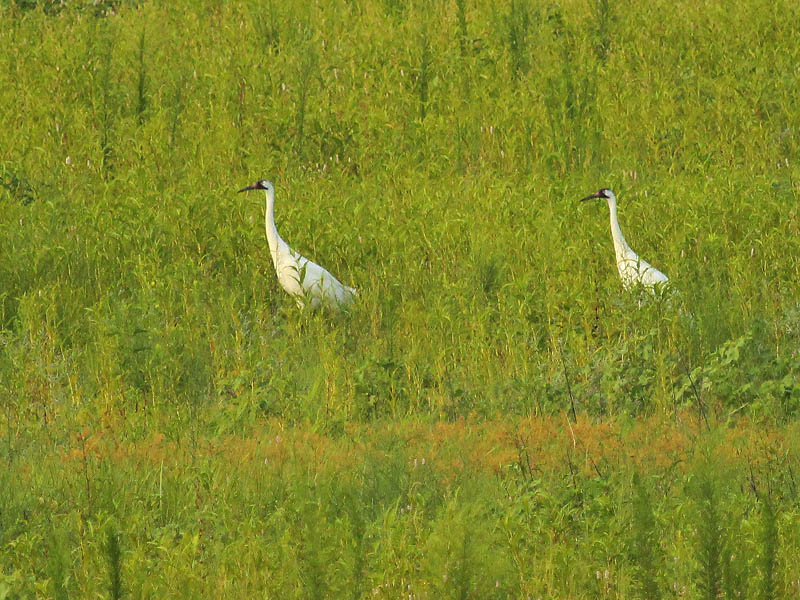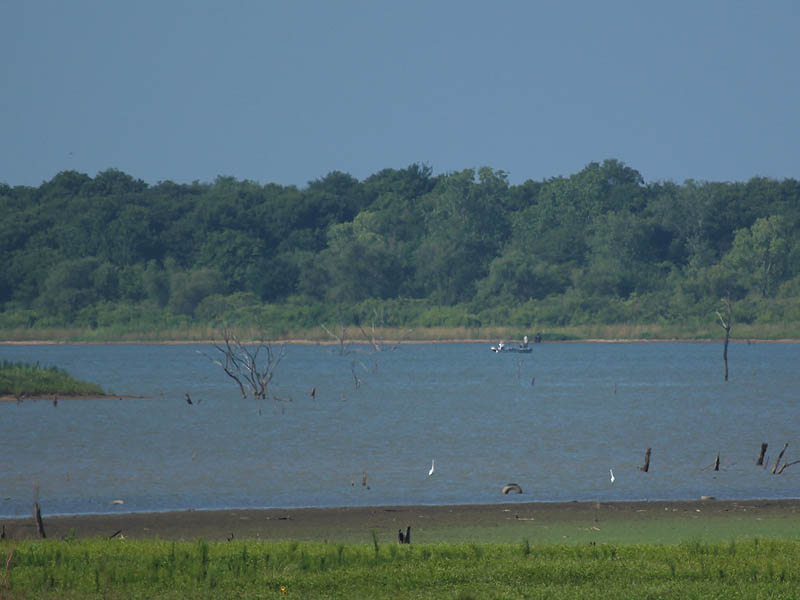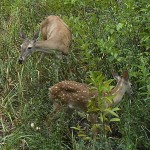NOTE: This post is part of a continuing series of observations: [ First | << Prev ]
Something has been building at Lake Lewisville over the last several weeks. The Whooping Cranes there have been acting differently and it was easy to get the sense that something was a little off. The group dynamic between they two sets of cranes was not quite working out. There seemed to be some tension.
On the days leading up to this visit I received word that the five juvenile Whooping Cranes know as the “Fenton Five” had left Lake Lewisville. They had traveled a couple of counties to the south and were unlikely to return. It was with a heavy heart that I received that news.
I considered it good news, though, to hear that two of the seven Whooping Cranes were still present at Lake Lewisville. These were the two that I had originally followed at Lake Ray Hubbard earlier in the year. I looked forward to seeing them, but when I arrived I found that they too were acting peculiarly.
The two whoopers were much further north on the flood plain than I had ever seen them before. They were foraging in the tall grass, moving back and forth across my field of view. Over the next 45 minutes or so they worked their way to the south side of the floodplain where they continued their foraging along the banks of the creek.



They spent another 30 minutes at this location, and then they took to the air. They flew directly to the water’s edge skimming just above the grassy floodplain as they went.
Once at the lake, the two cranes busied themselves with bathing and preening. They may have even dozed for a little bit—on one leg with their heads tucked under their wings.




While the cranes slept, I busied myself with other observations. There was a lot of activity in this part of the lake on this Saturday morning. Far to the south a fisherman worked the shoreline. A little later a bass boat made a brief foray into our secluded finger of the lake. I was most surprised when paraglider buzzed over the floodplain heading northwest to southeast.



Meanwhile, the two Whooping Cranes began to stir again, and soon they both took flight. The pair headed due west, and I was sure they were on their way to the cove where they spent time last week.
But they were not. Instead the two birds worked to gain altitude. Once above the trees they flew in tight little circles as the continued to gain height—all the while drifting to the west.
This was completely new behavior for the cranes as well. I had not seen them do anything like this in the past. Eventually, the cranes got so high and had moved so far away that I completely lost sight of them—even through my camera’s telephoto lens.
Changes.


Since that morning I have received news that these two cranes have also left Lake Lewisville. They are still in North Texas, but they are far enough away now that it is unlikely they will return. We wish them well!
So, this then marks the end of my efforts to document the activities and adventures of the Louisiana Whooping Cranes in the Dallas/Fort Worth Metroplex. It is a good time to reflect on the entire experience.
And what an experience it was! I have been following these Whooping Cranes for thirteen-plus weeks now, and I have loved every minute of it. It has been an incredible privilege to participate in the observing of these birds and the recording of their behaviors. This really was a special occurrence—truly once in a lifetime.
But this was also a challenging project to work on in some ways. There was always a sense that something more could be done. That opportunities were being missed. That I could be doing a better job.
Texas Parks and Wildlife has created a set of guidelines that are important to follow when observing Whooping Cranes. One of these guidelines stipulates a 2000 foot distance be maintained between observers and cranes. Like all of the other guidelines, this one was designed with the well-being of the birds in mind.
The exact nature of the rule is a little difficult to pin down. It’s never been clear to me if it is stipulated by law, or if it is a hard-and-fast rule, or if it is just a strongly worded suggestion. Also vague is if there are any penalties associated with breaking it.
Whatever the case, I think it is a good recommendation. It ensures—to a reasonable degree—that the cranes are not disturbed when being observed. It also helps to make sure that impressionable young birds do not become too comfortable around people. It is important that these cranes develop and maintain a healthy wariness.
When the cranes were at Lake Ray Hubbard earlier in the spring it was easy to follow the 2000 foot viewing restriction. At Lake Ray Hubbard the Whooping Cranes were consistently over 3000 feet away from the best viewing locations. The lake waters made a closer approach a dicey proposition.
At Lake Lewisville the situation was different. Even the preferred and approved viewing locations at Lake Lewisville were not always far enough away to provide for a 2000 foot viewing distance. When the cranes spent time near the water’s edge they were often several hundred feet inside the stipulated 2000 foot radius. Anyone who watched the whoopers from these spots was technically in violation of the rule from time to time. But, if you were going to observe the cranes in a meaningful way you had to a make an exception in this case. Any further away and the cranes would have been blocked from view by the intervening terrain.
The real challenge at Lake Lewisville was resisting the urge to move closer to the whoopers. The landforms and vegetation here were particularly conducive to making a stealthy approach. On an ordinary day, using an appropriate amount of care, it would have been possible to close the viewing distance down to just a couple of hundred feet or less. The vegetation provided enough cover that the cranes never would have known you were there.
It may have been possible to collect an entire portfolio of gorgeous, crystal clear photographs of these beautiful birds. They would have been the pictures of a lifetime!
This thought was often in my mind as I stood for hours at the approved viewing location taking blurry, long distance photographs. But for me, the welfare of the birds always won out, and I always did my best to honor the viewing recommendations.
On rare occasions the atmospherics around the birds would work to my advantage. A favorable combination of light, shadow, and air stillness would sometimes allow me a photograph that was more crop-able than the others, but in wildlife photography there is no substitute for proximity. These photographs would always pale in comparison to what would be possible at closer range.
My highest quality pictures are what I shared with you here on the web site. They are marginal at best, but they tell an important story, and as a consequence I am satisfied. I hope you are too.
With that being said, there were a couple of occasions where fortune afforded me the opportunity to observe and photograph the birds at significantly closer than the prescribed distance. I shared those pictures here on the website as well.
Once when I was stationed on the floodplain observing the cranes at well over the 2000 foot limit, the birds took to the air and flew almost directly over my location and at very low altitude. This was perhaps the most special moment of the entire project.
Another time, I went to investigate a new section of the lake that I believed the cranes may have been spending time in. I was not sure that the whoopers would be there as I headed to the isolated spot, but I made my way through the woods very carefully just in case. When I finally emerged from the trees, I found myself in a well-concealed location roughly 650 feet from the cranes. They never knew I was there.
I took a quick series of pictures and then promptly removed myself from the immediate area. The entire encounter lasted only a brief two to three minutes. Still, it was spectacular and memorable.
My last close encounter was recorded in the photographs and video included in this post. On this occasion the Whooping Cranes had moved within 800 feet of the approved viewing area of their own volition. This time I was afforded the opportunity to watch the pair forage in the floodplain at close range and over an extended period of time.
In addition to myself, there were a couple of joggers, a number or residents of a nearby subdivision, and about a dozen construction workers all in violation of the 2000 foot viewing distances rule to one degree or the other. But the distance to the birds was still sizable and they were showing no signs of being alarmed, so I continued to record their activities. Any further away and they would not have been observable.
The pictures I recorded during these close approaches are significantly better that the ones I was able to record at the distances specified in the TWPD guidelines, but they are nowhere near as good as what would have been possible at closer range. At 200 feet or less the photographs would have looked like family portraits. No matter. The rules are the rules. The welfare of the birds is the most important thing.
All seven Whooping Cranes are still present in North Texas as of the date this article posted. If you come across them please do your best to honor the 2000 foot guideline. It is good policy.
NOTE: This post is part of a continuing series of observations: [ First | << Prev ]







Well, they are gone from Lake Lewisville. I feel privileged to have seen them, and am very grateful to you for sharing with all of us the photos and commentary on the web site. We all wish the cranes well as they journey toward maturity. With good fortune, they will be nesting in southern climes in a few years.
Yep, it looks like the story of the cranes in the Dallas/Fort Worth area is just about over… But, these crazy birds have shown us time and again that they have minds of their own! I hope to get the occassional update as the cranes continue on their adventure!
You may be seeing them some more as they “roam” around quite a bit at this age but I personally was hoping they would go further North and become at least semi-migratory as static flocks historically have not done well.
Chris, thanks for the precautions you have observed while observing and photographing these birds. Most people have no clue of the value of the few whooping cranes in the world–somewhere around 600 total birds wild and in captivity. Having done volunteer work with the eastern migratory flock (established by OM, operationmigration.org, over the last 12 years and currently working on this year’s chicks for year 13) I have a good understanding of the effort and resources expended to make sure this bird doesn’t disappear entirely. Sharing your observations has been greatly appreciated.
One place where I have really dropped the ball on this project is in not emphasizing how extremely rare these endangered birds are. I should have also made more mention of all of the effort and resources that have gone into their ongoing recovery programs.
Dear Chris,
Thank you again for sharing your photos and video with us all, as well as, your commentary! It is really important to get the word out about this beautiful Endangered Species, the North American Whooping Crane. All the hard work by the people in the Whooping Crane Eastern Partnership (WCEP) is starting to take effect, too. Last year’s chicks at Operation Migration have returned to their flight training grounds at White River Marsh in Wisconsin to claim their territory and check out this year’s class of chicks who are now in flight training for their first migration to Florida in the early Fall. Please feel free to go to the website http://www.operationmigration.org to get all the latest news and information on these beautiful birds and the progress they are making to become a sustained population for the Eastern U.S. once again.
Margie Tomlinson, (West Coast/Oregon volunteer for Operation Migration)
Well, you are certainly welcome, Margie. Thank you for all of the great work you and your organization are doing to help establish new populations of these wonderful birds. These are critically important efforts designed to give the species as a whole some protection again disaster and disease!